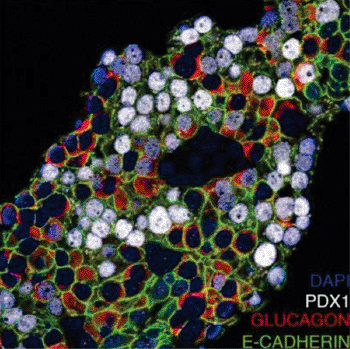Pancreatic Chromatin Manipulation Generates New Insulin Producing Cells
By LabMedica International staff writers
Posted on 04 Mar 2013
Genomic researchers have created insulin-producing pancreatic beta cells through the selective enzymatic manipulation of the chromatin of glucagon-producing alpha cells.Posted on 04 Mar 2013
Glucagon is a hormone secreted by alpha cells in the pancreas that raises blood glucose levels. Its effect is opposite that of beta cell insulin, which lowers blood glucose levels. The pancreas releases glucagon when glucose levels fall too low. Glucagon causes the liver to convert stored glycogen into glucose, which is released into the bloodstream. High blood glucose levels stimulate the release of insulin. Insulin allows glucose to be taken up and used by insulin-dependent tissues. Thus, glucagon and insulin are part of a feedback system that keeps blood glucose levels at a stable level.

Image: Treatment of human islets with the histone methyltransferase inhibitor Adox results in co-localization of the beta-cell specific transcription factor PDX1 (white) in a substantial subpopulation of glucagon-positive cells (red), indicating partial endocrine cell-fate conversion (Photo courtesy of Nuria Bramswig, Perelman School of Medicine, University of Pennsylvania).
Loss of beta cells and subsequent lack of insulin causes diabetes. One theoretical approach to correcting this problem is to convert some other cell type, such as alpha cells, into beta cells. To this end, investigators at the University of Pennsylvania (Philadelphia, USA) launched an in-depth study of the alpha and beta cell genomes.
They used ChIP sequencing and RNA sequencing analysis, to determine the epigenetic and transcriptional landscape of human pancreatic alpha, beta, and exocrine cells. ChIP sequencing is a method used to demonstrate the association between transcription factors or other DNA-binding proteins and specific regions of genomic DNA. Chromatin is isolated from preparations of nuclei, chemically cross-linked, and sheared to provide short fragments. Antibodies are used to immunoprecipitate the specific DNA-binding protein and with it, the fragment of DNA to which it is bound. Polymerase chain reaction (PCR) is then used to identify the presence of specific DNA fragments.
The investigators reported in the February 22, 2013, online edition of the Journal of Clinical Investigation that compared with exocrine and beta cells, differentiated alpha cells exhibited many more genes bivalently marked by activating and repressing histone modifications. Thousands of these genes were in a monovalent state in beta cells, carrying only the activating or repressing mark. Epigenomic findings suggested that alpha to beta cell reprogramming could be promoted by manipulating the histone methylation signature of human pancreatic islets.
Treatment of cultured pancreatic islets with a histone methyltransferase inhibitor led to co-localization of both glucagon and insulin and glucagon and insulin promoter factor 1 (PDX1) in human islets and co-localization of both glucagon and insulin in mouse islets. Therefore, mammalian pancreatic islet cells displayed cell-type–specific epigenomic plasticity, suggesting that epigenomic manipulation could provide a path to cell reprogramming and novel cell replacement-based therapies for diabetes.
"To some extent human alpha cells appear to be in a "plastic" epigenetic state," said senior author Dr. Klaus H. Kaestner, professor of genetics at the University of Pennsylvania. "We reasoned we might use that to reprogram alpha cells towards the beta-cell phenotype to produce these much-needed insulin-producing cells. We treated human islet cells with a chemical that inhibits a protein that puts methyl chemical groups on histones, which - among many other effects - leads to removal of some histone modifications that affect gene expression. We then found a high frequency of alpha cells that expressed beta-cell markers, and even produced some insulin, after drug treatment."
"This would be a win-win situation for diabetics," said Dr. Kaestner. "They would have more insulin-producing beta cells and there would be fewer glucagon-producing alpha cells."
Related Links:
University of Pennsylvania













